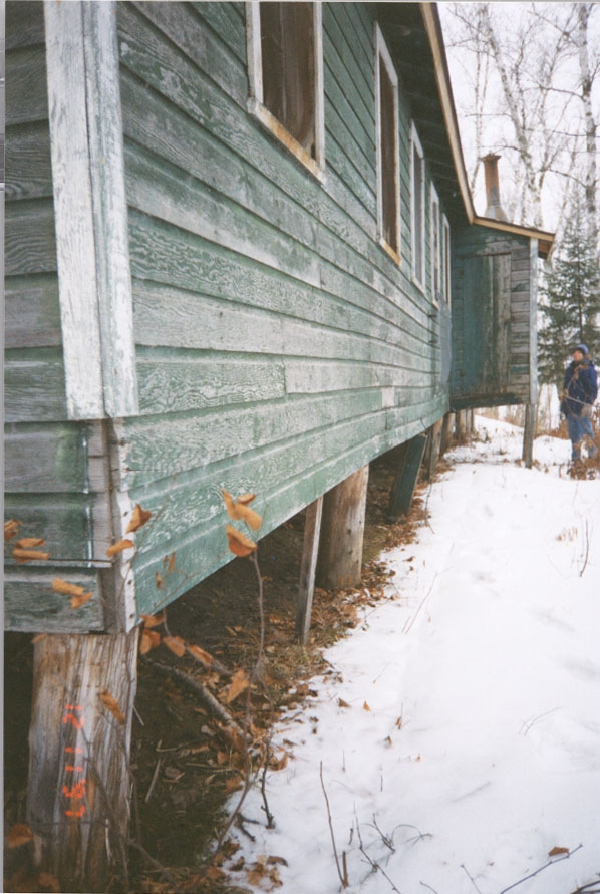Last updated: July 5, 2018
Article
Renewal in the Forest

Photo courtesy of Chippewa National Forest.
This is not to say that the buildings are all in pristine condition. Neither designed nor intended for long‐term use, in the 66 years since the last CCC enrollee left camp, subsequent uses, deterioration, demolition and fire have left their mark. Of the original 25 buildings constructed, 13 remain standing –thanks largely to the commitment of the Chippewa National Forest staff and the efforts of many preservation partners, including the Minnesota Preservation Alliance, the Minnesota State Historic Preservation Office, the Minnesota Conservation Corps, and numerous volunteers.
In the past year, the most recent preservation efforts have targeted two of the surviving buildings. Another five still await sorely‐needed preservation work. Stabilization work on the officers quarters and the recreation hall were funded in part through a Scenic Byways grant, with matching funds provided by the Chippewa National Forest. On both buildings, the critical needs addressed the design and creation of permanent foundations and installation of structural reinforcements.
As befit a “temporary” portable camp, all of Rabideau’s buildings had been minimally designed following a design specified by the U.S. Army. Such portable camps were intended to be dismantled, transported and re‐erected if needed. To facilitate this option, the buildings had been set on log posts directly in the ground. This situation, and particularly the lack of permanent foundations that could accommodate the cyclical freezes of Minnesota’s climate, exacted a toll on the buildings. Over the years they had begun to resemble oversized caterpillars.
Work on the officers quarters —which sat on a hill that itself was sliding columns, installing additional floor joist supports and adding skirting that hid the new foundation details. The design was sensitively developed following the Secretary of the Interior’s Standards for Rehabilitation, ensuring that the new foundation system met current building codes yet did not destroy the officers quarters’ integrity.
As befit a “temporary” portable camp, all of Rabideau’s buildings had been minimally designed following a design specified by the U.S. Army. Such portable camps were intended to be dismantled, transported and re‐erected if needed. To facilitate this option, the buildings had been set on log posts directly in the ground. This situation, and particularly the lack of permanent foundations that could accommodate the cyclical freezes of Minnesota’s climate, exacted a toll on the buildings. Over the years they had begun to resemble oversized caterpillars.
Work on the officers quarters —which sat on a hill that itself was sliding columns, installing additional floor joist supports and adding skirting that hid the new foundation details. The design was sensitively developed following the Secretary of the Interior’s Standards for Rehabilitation, ensuring that the new foundation system met current building codes yet did not destroy the officers quarters’ integrity.

Photo courtesy of Chippewa National Forest.
The Chippewa National Forest is actively working with partners to determine new uses for the camp that will ensure its longterm viability while preserving its unique character. According to Heritage Program Manager and Forest Archeologist Andrea LeVasseur, a group of representatives from the Minnesota Conservation Corps, Leech Lake Area Boys and Girls Club, Cass Lake‐ Bena School District, the Cass lake Tourism Partnership, and other organizations are exploring the reuse of Camp Rabideau.
The group of organizations is proposing to establish a Conservation Academy and Learning Center to provide opportunities for youth and young adults to connect to the natural environment, explore careers in resource conservation fields as well as skilled trades, and experience outdoor recreational activities. The camp would be operated under a special use permit with the Forest Service.
* Mount Morrison CCC Camp in Colorado may compliment the Rabideau CCC Camp property in representing the diversity of New Deal relief programs initiated by the Federal government.
Originally published in "Exceptional Places" Vol. 2, 2007, a newsletter of the Division of Cultural Resources, Midwest Region. Written by Dena Sanford.
